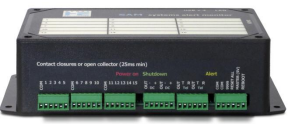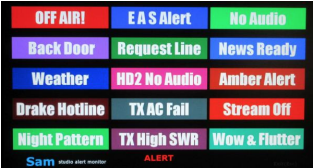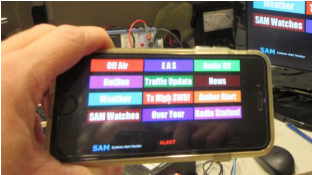A Modern Version of the “Light Bank”

[August 2017] With fewer and fewer people live in radio studios – and many of those listening to the “program audio” (instead of off-air) – newer and better ways to alert station personnel to problems are needed. Here is one, presented by Hank Landsberg of Henry Engineering.
For many years, one component of a typical radio station studio was some kind of “alert light” box: a device that could let the DJ or board operator know that something important was happening.
In the days of “one station, one air studio,” the DJ might be alerted with something as simple as a light bulb or strobe or a buzzer in the studio. Multiple alerts might develop a bank of lights for off-air, silent sense, EAS message, back door entry, or bat-phone alerts, for example.
Game Changer
Then consolidation took over, and suddenly we had large studio complexes housing multiple radio stations with dozens of studios.
Instead of having to watch over one air signal, now there were several, with lots of parameters and conditions for personnel to monitor: multiple transmitters, program streams, phone lines, STLs, and so on.
Some stations have used fixed-message visual alert devices, but even the multiple-message units are less than ideal where equipment and systems were often changed or updated. Either you did not have enough messages or it was difficult to change the message when the equipment or systems being monitored were changed. More to the point: in today’s world, nothing stays the same for very long!
It is time to retire the old “light bulb alert box!”
The Solution
What is needed for today’s studio complex is a device that (a) can monitor lots of gear simultaneously, (b) provides easy-to-see visual alerts when there is something that needs attention, (c) can be easily updated as monitoring needs change, and (d) can provide multiple ways of alerting personnel.
With these goals in mind, we created a new way to keep a watchful eye on your station and its hardware. It is the new Systems Alert Monitor, or SAM, a video-based device that monitors up 2 to 15 status inputs, and provides an instant visual, audible, and/or email indication if anything or needs attention by station personnel.

The Systems Alert Monitor consists of a Status Interface Unit which generates “alert” text messages displayed on a video monitor. Because the system is software-based, the text of the alert messages and the way the system operates can be easily changed or reconfigured as necessary.
15 Point Monitor
SAMs Status Interface Unit has 15 Alert inputs for monitoring your facilities equipment and systems that can be wired to virtually anything that provides some kind of status or fault signal.
For example, the station air monitor provides a fault signal if the carrier goes off the air. A silence-sensor provides a fault signal if the station loses channel or all audio. EAS receivers output a signal when an EAS message is received. Or your transmitter remote control system generates an alarm output if the transmission line has high SWR or if someone enters the building.
These and other situations can be monitored by SAM, which displays text messages on a video monitor easily seen by the DJ or board operator on duty.

Input Flexibility
All of SAM’s Alert inputs should be isolated “dry” GPI contact closures; this is fairly common with professional broadcast gear.
But, since some equipment provides a DC Voltage instead of a contact closure, SAM includes two Input Isolator circuits that can accept a DC Voltage or any connection not truly isolated.
In addition, SAM also includes two Ring Detectors that will sense ringing on a standard POTS phone line. These would be used to trigger a SAM alert when the line rings, e.g., for Listener Lines or for that call from the PD on his hotline.
Quick Setup/Changes
The beauty of SAM is its ease of setup. It can be customized by the user for each installation in a matter of a few minutes, using a standard PC keyboard and mouse (SAM has 4 USB ports).
And, if the options are selected, an audio message can be played and/or an email message sent for that specific Alert input.
Once the Setup is complete (See sample setup screen here), SAM is started and it begins to scan all 15 Alert inputs.
When an Alert is triggered, the text message flashes several times on the video screen then it stays “solid-on” until the specified Display Time has lapsed.
If no Alerts inputs are active the screen will be blank – or SAM can display your station logo via a jpg file.
If anything needs to be changed or updated, it is a simple as running the Setup screen again and changing the message text, colors, and Alert options as needed.
Sam in Action
In most installations, SAMs Status Interface Unit will be located wherever there is access to your monitored gears’ status/fault wiring – usually in the rack room or engineering shop. SAM’s video output is fed to the monitor(s) in your studio(s) via HDMI (or via IP on your stations LAN using RealVNC Viewer).
SAM uses an internal web-server that generates a web page. You can use VPN (free download from their site) and log into SAM using any PC that’s on your LAN.
Now any PC on your station’s LAN can view the SAM screen. You can even see it using your smart phone via the station’s wireless LAN.

The Systems Alert Monitor is ideal for use in studios, transmitter plants, or for any control facility. It is an effective way to monitor multiple systems simultaneously and notify personnel of important system status or priority situations.
The SAM is available from any Henry Engineering dealer, at a list price of $695 (video monitor not included).
– – –
For more information, contact Hank Landsberg at Henry Engineering or visit the web site: www.henryeng.com
